Cartoons: Lawn Laughs
Want even more laughs? Subscribe to the magazine for cartoons, art, inspiring stories, fiction, humor, and features from our archives.
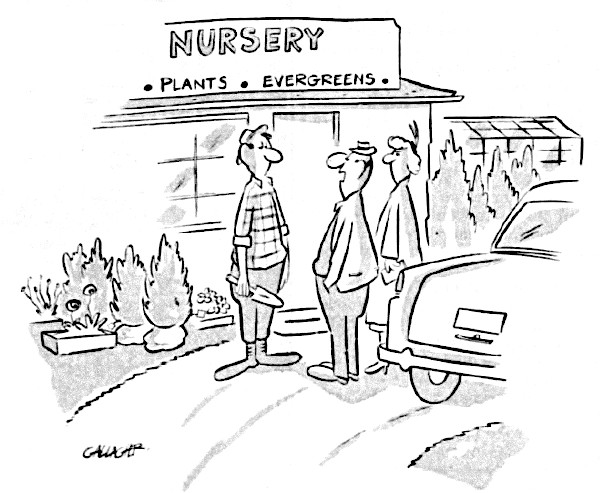
Gallagher
May 14, 1955
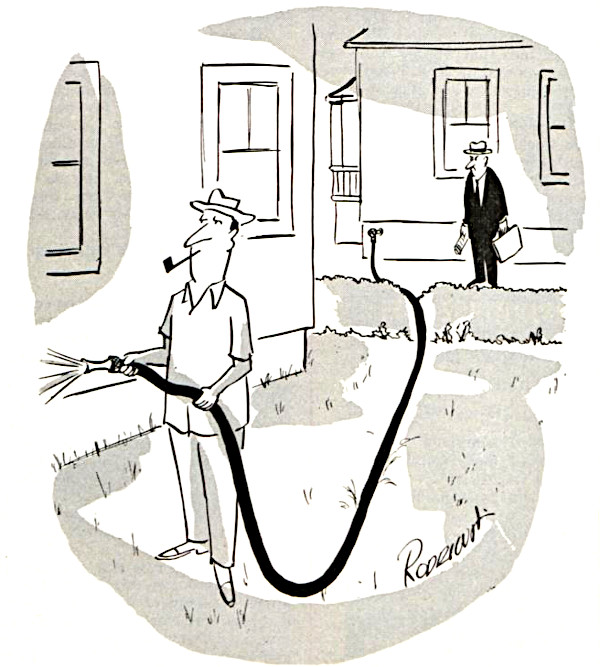
September 27, 1952
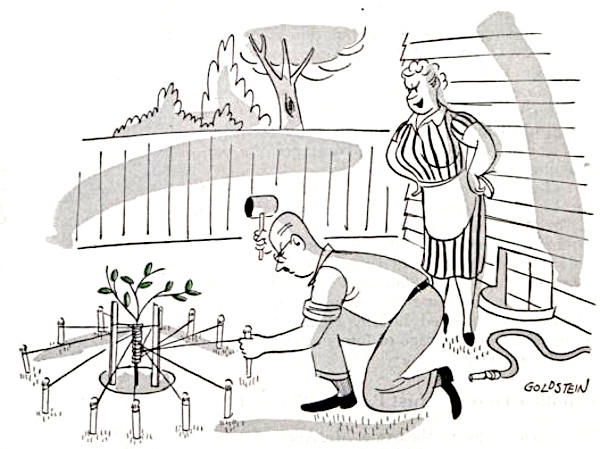
Goldstein
September 20, 1952
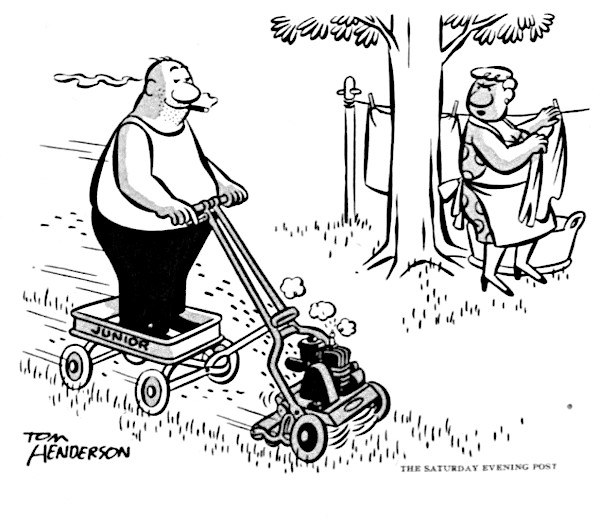
August 23, 1952
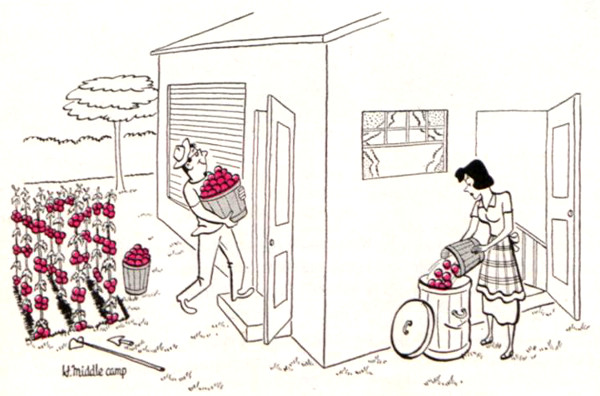
August 18, 1951
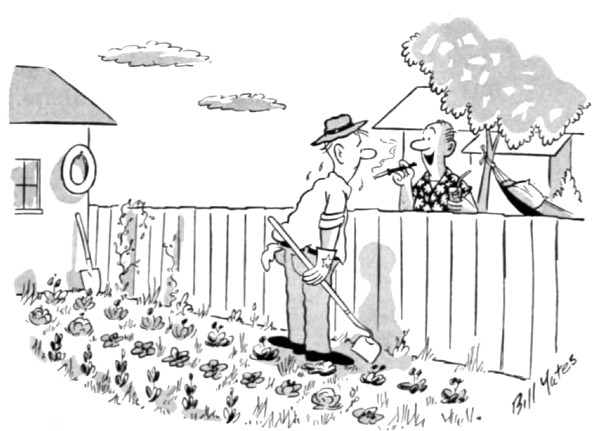
Bill Yates
June 19, 1954
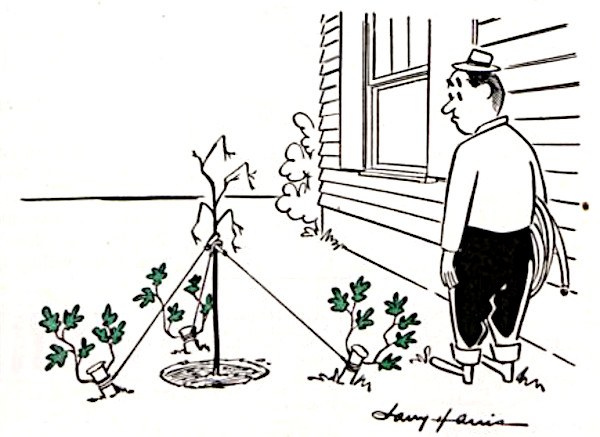
June 14, 1952
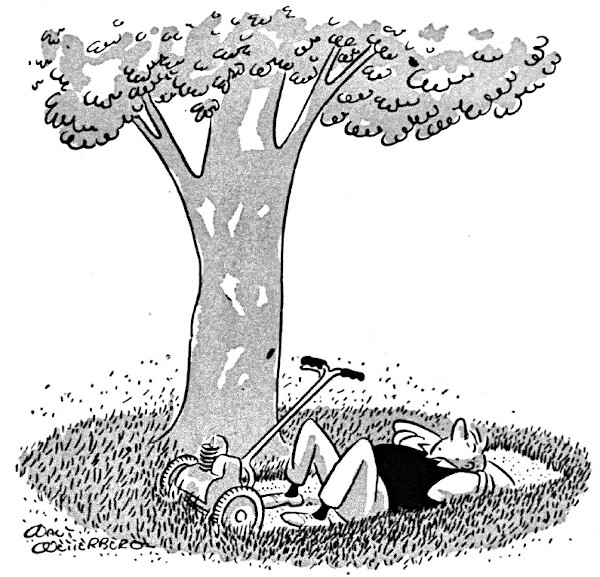
June 7, 1952
Want even more laughs? Subscribe to the magazine for cartoons, art, inspiring stories, fiction, humor, and features from our archives.
Tips for Planting Tomatoes
For most of the northern part of the United States, Memorial Day marks the date when tomatoes can be safely planted to avoid frost. Many intrepid tomato growers may already have picked out their plants and set them out. But it’s not a bad idea to wait. If you buy plants early, keep them in a warm place and set them out in the sun a few hours per day. Don’t plant tomatoes until the air temperature is at least 50 degrees F during the day and night. Use the extra time to prepare the soil just right to ensure your tomatoes, like army recruits, will be “all that they can be.”
Planting Tips
Choose a spot that gets at least eight hours of sun a day.
Set plants out in early evening to reduce the stress and heat injury.
Option 1: Dig a hole the size of a basketball (but don’t put a basketball in it). Instead, fill the hole with water the day before planting and let it soak in. Fill the hole halfway with compost and add a small amount of balanced fertilizer, i.e. 5-5-5.
Take off all but the top four or five leaves of the plant and bury it up to the lowest leaves. Then soak the soil, but try not to get water on the plant.
Option 2: Put down 5-5-5 fertilizer and till it in. Then dig a shallow trench. Remove all but the top leaves from the stem and lay the plant and root ball on its side in the trench. Bury it leaving just the top leaves showing. This way, the plant will absorb more nutrients, and the stem will absorb more heat, causing it to fruit earlier.
Stake or cage your plants early to avoid breaking off stems and leaves after the plants have grown.
Unless it has rained, water plants every 10 days, soaking soil to 6-10 inches deep.
When blossoms form, feed the plants with a high phosphorus (middle number) fertilizer such as 12-48-12 or 10-55-10.
If you want fewer, but larger tomatoes, prune your plants by pinching out the suckers, which are the leafy shoots that grow from the “V” between the leaves and the central trunk.
Visit your tomato plants frequently. They won’t get lonely, but they may need your help to rid them of tomato worms or other pests should they appear.
Make your own pest repellent:
Put 6 cloves of garlic, half an onion, 1 tablespoon of cayenne pepper, and 1 tablespoon of Tabasco sauce in a blender with 1-2 cups of water. Blend until smooth. Mix with 1 tablespoon dishwasher liquid and 1 quart water. Let sit for a day, then strain into a spray bottle to spritz on your tomato plants. This will keep insects away and may help thwart rabbits and raccoons.
Are You Giving Your Garden the Right Nutrition?
What you feed your plants can make a mighty difference when you come to harvest your vegetables and flowers. And spring is the time to make sure they get enough of the 13 essential mineral elements required for normal growth. Fortunately, most soils contain the micronutrients that vegetable and flowering plants require in small amounts such as boron, manganese, copper, zinc, iron, molybdenum, and chlorine. You only need to add these elements in particular instances, when some abnormal plant response indicates a deficiency.
The secondary elements—calcium, magnesium, and sulfur—are more important and occasionally they need to be replenished in some soils. They can be replaced by adding minerals containing them, such as ground limestone (calcium carbonate), gypsum (calcium sulfate), or powdered sulfur to the soil. A single application is enough to keep plants healthy for several years.
The most important plant nutrients that must be replenished annually are nitrogen (N), phosphorus (P), and potassium (K). They are represented on chemical fertilizer packages by numbers. A 10-5-5 fertilizer, for example, indicates a mixture that is 10 percent nitrogen, 5 percent phosphorus, and 5 percent potassium. Each nutrient has a different but vital role to play in making your garden successful.
Nitrogen
Nitrogen is the primary nutrient that makes plants grow, and it must be added periodically to the soil because plants use it up rapidly. Gardeners can get their plants growing in spring by adding either chemical or organic sources of nitrogen to the soil. Chemical sources include ammonium sulfate, ammonium nitrate, calcium nitrate, and sodium nitrate. Organic sources include manure, blood meal, cottonseed meal, hoof and horn meal, fish emulsion, and soybean meal. You can also increase nitrogen by adding grass clippings or leaf mold. But don’t get carried away. Too much nitrogen can cause excessive stem and leaf growth at the expense of flowering and fruiting.
Phosphorus
Phosphorus is the primary nutrient that encourages rooting, blooming, and fruit production. Because it is slow to move through the soil, it should be added to the soil prior to or during planting and placed close to the plant roots. Generally, gardeners should use a higher ratio phosphorus fertilizer in spring such as a 5-10-5 or a 10-20-10, with phosphorus being the middle number. Both of these fertilizers have a two to one ratio of phosphorus to nitrogen and potassium. The 10-20-10, however, is twice as concentrated as the 5-10-5, so you only have to use half as much .
Phosphorus becomes less available to plants when soils are acidic, cold, or wet. If growing plants develop a bluish cast or turn dull green on top and bronze or purple underneath, they may need more phosphorus. Adding extremely fine bone meal to the soil can give your plants a phosphorus boost. Also, rock phosphate which is about one-third phosphorus can be added to acidic soils.
Potassium
Potassium helps plants build proteins and sugars and aids them taking in other nutrients and withstanding cold. Most important, potassium helps plants grow larger, more colorful, and more abundant fruits and flowers. If leaves turn grayish, yellow, mottled, or brown and edges curl late in the season when fruits are developing, it may be a sign of potassium deficiency. A quick fix is to spray plants with fish emulsion or liquid kelp or to side-dress them with wood ashes, which are about 20 percent potassium.
The richest sources of potassium are the synthetic fertilizers potassium chloride and potassium sulfate, which are both fast acting.
When using chemical fertilizers, always follow the application rates recommended on the package. Using more will not aid growth and will result in injuring your plants. Organic fertilizers are generally slower acting than chemical fertilizers, but they will last longer and are less likely to be over applied.